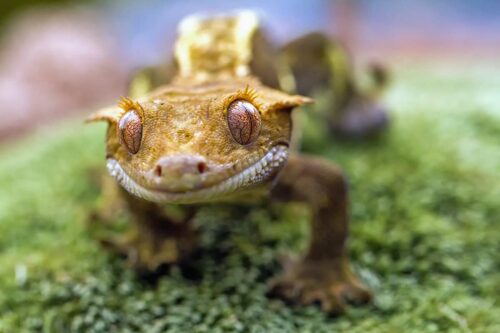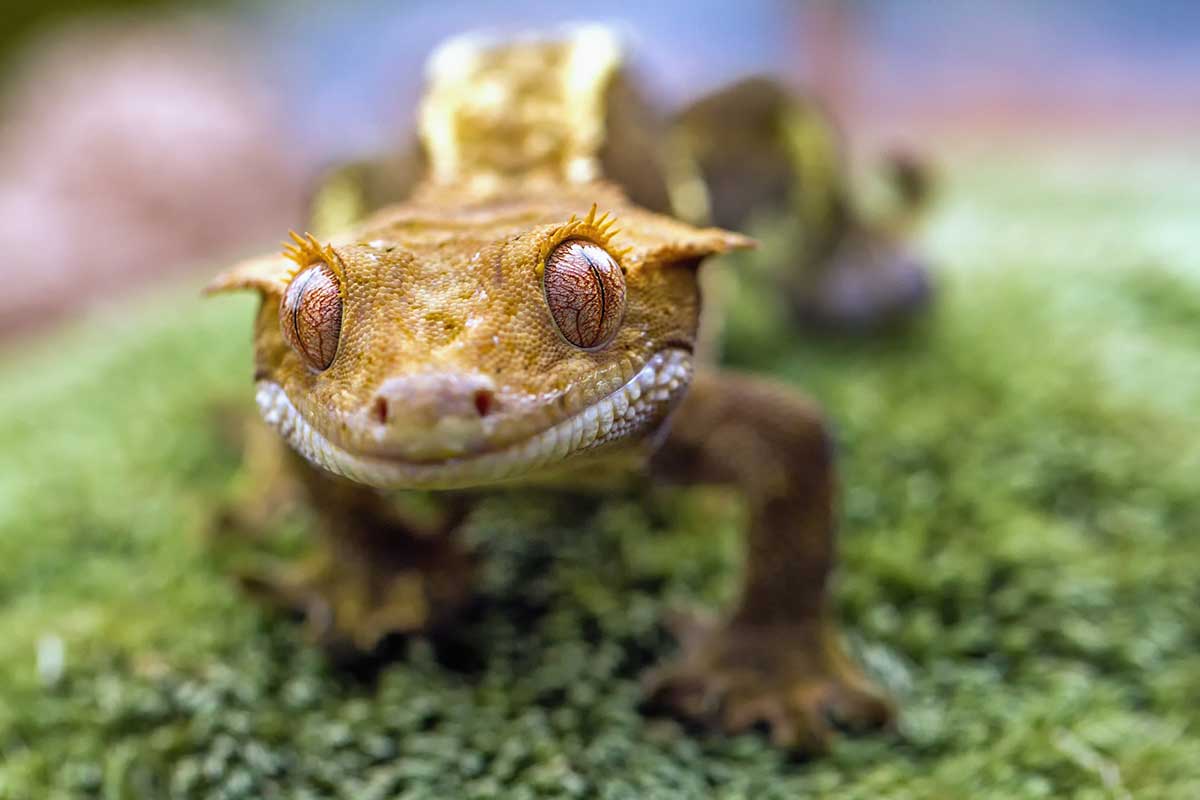If you haven’t cared for a reptile before, contemplating the shedding process can be confusing. How exactly do they shed their skin? How often does it happen?
And how do you know that your crestie has shed properly and won’t suffer any adverse health effects from an incomplete shed?
Today, we’ll take you through everything you need to know about crested gecko shedding, starting with how often you should expect them to shed based on their age, what a healthy shed looks like, and warning signs of an unhealthy shed.

We’ll also share some tips for caring for your crestie that will help ensure a healthy shed every time.
You may also be interested in reading our guide to reptiles and pets and the essential things you should know before bringing a crestie, or any reptile, home.
How Often Do Crested Geckos Shed?
The frequency of crested gecko shedding depends on their age. Baby geckos shed more often in order to keep up with their rapid growth. As they age, they shed much less often, but cresties still shed frequently throughout their lives.
Babies, in the first two months of life, will grow to about three inches. They will then double in size until the age of about a year, growing more quickly in the first six months and slowing down a bit in the final months.
In the first six months of their life, they will shed two or three times a week, and then this will decrease to once or twice a week between six and 12 months of age.
In the following year or two, as young adults, you can expect them to grow another inch or so until they are between seven and nine inches long. During this period, they will shed once every two to four weeks.
Once they are about three years old, they are fully grown and will only need to shed about once a month. They may shed a little more often if they’re dealing with parasites, such as mites, or other bacteria or infections.
The shedding helps them rid themselves of some of these parasites.
What Does Healthy Shedding Look Like?
Crested geckos shed their entire skin in one go, but that doesn’t mean it will come off in one piece.
You’ll notice they are ready to shed as they will have gray patches of skin on their bodies, and may even have entire limbs where the skin turns gray. This is because the skin is dead and ready to shed.
As an adult, your gecko may stop eating two to three days before they’re ready to shed, and their activity levels will diminish significantly.
This is because they are conserving energy for the shedding process. They will spend most of these days in hiding and rest in a damp corner of their terrarium. They use their tongue to loosen the skin from the body and complete the shed.
While cresties will prepare to shed for a few days, the actual shedding process will only take between 15 and 60 minutes. You may not even notice that it happens because they usually shed at night and then eat their shedded skin.
This provides an immediate nutrition boost following their period of fasting.
Because babies shed so frequently, this shedding cycle will be less obvious and you may come across their skins more often.
You’ll know the shed has been successful because they will look clean and vibrant in color following the shed. But you should examine your crestie afterwards to ensure they have, in fact, fully shedded their skin.
What Does An Unhealthy Shed Look Like?
The most common shedding problem that crested geckos suffer is an incomplete shed, when pieces of skin remain attached to the body. The remaining skin can lead to serious health problems.
One of the most common areas where skin will stick is between the digits. The now tight dead skin can cut off blood flow and lead to necrosis of the digit.
If left untreated, the digit may need to be amputated. In the worst cases, the necrosis may also spread up the limb and require more serious surgery.
The tail is also an area of concern when it comes to shedding. If the skin does not shed completely, it can lead the tail to drop off! Since crested geckos store fat and water in their tails, this can lead to malnutrition and dehydration.
With daily feeding, it can take around two months for a tail to fully grow back.
If you notice that your crestie has an incomplete shed, then you should contact your vet. In the meantime, give them a warm bath of 30-45 minutes twice a day to help loosen the dead skin so they might be able to remove it more easily.
Never try to peel away your crested gecko’s dead skin yourself. This is likely to lead to wounds that can easily become infected. Your vet will have special tools for removing dead skin and will apply ointments to prevent infection.
How To Care For Your Crested Gecko During Shedding?
Taking proper care of your crested gecko can go a long way to ensuring they have a healthy shed every time.
This all starts with maintaining proper humidity levels in their terrarium, as the right amount of moisture is essential to the shedding process.
Your crestie’s tank should usually have a humidity of 50% to 60%, but in the days prior to shedding, you’ll want to raise the humidity levels to 80%.
This can be done by misting the plants and sides of their enclosure several times a day, and placing a small bath of water in the tank to further raise humidity.
This should be deep enough for them to bathe in. But if they do choose to bathe, you’ll need to change the water regularly to ensure it stays clean. Wash the bath at least once a day with soap and warm water.
Invest in a hygrometer for your terrarium so you can properly monitor humidity levels. This is especially important if you’re adjusting humidity regularly, like you will need to do for a shedding crested gecko.
Make sure you lower the humidity levels back to normal about 24 hours after shedding is complete.
Living in a tank with high humidity can lead to respiratory and skin infections. Plus, fungus and bacteria thrive in humidity and can make your crestie’s terrarium unsafe.
This digital hygrometer and thermometer from Repti Zoo is one of the best options on the market for reptile terrariums.
You should also ensure that you have rough surfaces inside the terrarium, such as rocks and tree bark. Your crestie will rub against these to help loosen their skin for the shedding process.
You should also create a shed box within their habitat. This is just a small hiding place with humid conditions where your crestie can take shelter during shedding.
It should be filled with damp sphagnum moss, which should be moist but not soaked, again to prevent excessive bacteria growth. You’ll want to remove this when they aren’t shedding so as not to create excess humidity during normal periods.
In the days leading up to shedding, you should give your crestie a warm bath of 30-45 minutes each day. But outside of this, you should keep handling to a minimum pre-shed. This is a time when they prefer to hide and be alone.
Trying to handle them may also cause you to inadvertently remove skin that is not quite ready to come off, which can damage their skin.
Crested Gecko Shedding FAQs
How often should a crested gecko be shedding?
As an adult, a crested gecko will probably shed around once a month. If they shed more often, it could be a sign they are suffering from parasites. They will shed their skin frequently to try and expel them.
But younger, growing cresties shed more often to accommodate their rapid growth. They will shed a couple of times a week as babies, and every two to four weeks between the ages of one and three years.
Why do I never see my crested gecko shed?
You may go to bed one night seeing that your crestie is ready to shed, and then wake up the next morning to a lizard with glowing renewed skin and no sign of their old skin.
This is common because your nocturnal crestie will shed at night, and it can take as little as 15 minutes up to no more than one hour.
They also tend to eat their shed skin for nutrients, so you won’t see any evidence of the complex natural process that has just taken place.
Can I handle my crested gecko while shedding?
Crested geckos prefer not to be handled prior to shedding, as they will indicate by spending more time in their hides. It’s also not a good idea to handle them as you may accidentally remove loose skin before it is ready to be shed, damaging their skin.
In the days before shedding, limit your handling of your crestie to placing them in a warm bath for 30 to 45 minutes each day.
What happens if a crested gecko’s tail falls off?
One of the complications that can accompany an incomplete shed is your cretie’s tail falling off. This is not as bad as it sounds, as their tail will grow back, but this can take around two months.
In the meantime, your gecko has lost their reserves of fat and moisture that they use to survive. While they’re healing, ensure they are offered food every day and have access to clean water they can submerge themselves in.
That water will need to be changed at least once a day and their bath thoroughly cleaned.
Do crested geckos bleed when shedding?
If your crestie has a nice healthy shed, there should be no evidence of bleeding. But sometimes skin can decide it doesn’t want to go and some blood can be left behind.
These wounds represent a risk of infection, so you should monitor your crestie while they are healing.
It’s best to avoid excessive handling of your geck at this time as your hands can transfer bacteria to your pet.
Ready To Shed?
Shedding is a natural part of the life of a reptile, and your crested gecko will know when and how to shed themselves innately without any help.
What you need to do is ensure they have the right environment to facilitate shedding.
This means controlling humidity levels and increasing them when your crestie is ready to shed, giving them rough surfaces to rub against, and making sure they have a nice humid spot to hide out in when they are ready to renew their skin.
The only other thing you can really do is give them a warm bath daily when they are preparing to shed and leave them alone to do their thing.
You should then examine them carefully after shedding just to ensure they have fully shedded their skin and that no dead skin clinging on that could cause medical issues.
If you do notice that your crestie has performed an incomplete shed, don’t try to fix this yourself, as this can do more harm than good. Instead, give them further warm baths to see if they can remove the skin themselves and make an appointment with your vet.
Looking for other tips on caring for your crested gecko? Read our guide to what fruits to feed your crestie and which ones are best avoided.
- Can Guinea Pigs Eat Potatoes? Foods To Avoid - September 24, 2023
- Can Guinea Pigs Eat Carrots? Feeding Advice - September 23, 2023
- How To Make A DIY Bearded Dragon Enclosure - September 22, 2023

